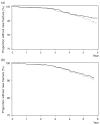Fracture incidence in HIV-infected women: results from the Women's Interagency HIV Study
- PMID: 20859192
- PMCID: PMC3108019
- DOI: 10.1097/QAD.0b013e32833f6294
Fracture incidence in HIV-infected women: results from the Women's Interagency HIV Study
Abstract
Background: The clinical importance of the association of HIV infection and antiretroviral therapy (ART) with low bone mineral density (BMD) in premenopausal women is uncertain because BMD stabilizes on established ART and fracture data are limited.
Methods: We measured time to first new fracture at any site with median follow-up of 5.4 years in 2391 (1728 HIV-infected, 663 HIV-uninfected) participants in the Women's Interagency HIV Study (WIHS). Self-report of fracture was recorded at semiannual visits. Proportional hazard models assessed predictors of incident fracture.
Results: At baseline, HIV-infected women were older (40 ± 9 vs. 36 ± 10 years, P < 0.0001), more likely to report postmenopausal status and be hepatitis C virus-infected, and weighed less than HIV-uninfected women. Among HIV-infected women, mean CD4(+) cell count was 482 cells/μl; 66% were taking ART. Unadjusted incidence of fracture did not differ between HIV-infected and uninfected women (1.8 vs. 1.4/100 person-years, respectively, P = 0.18). In multivariate models, white (vs. African-American) race, hepatitis C virus infection, and higher serum creatinine, but not HIV serostatus, were statistically significant predictors of incident fracture. Among HIV-infected women, older age, white race, current cigarette use, and history of AIDS-defining illness were associated with incidence of new fracture.
Conclusion: Among predominantly premenopausal women, there was little difference in fracture incidence rates by HIV status, rather traditional risk factors were important predictors. Further research is necessary to characterize fracture risk in HIV-infected women during and after the menopausal transition.
Figures

References
-
- Brown TT, Qaqish RB. Antiretroviral therapy and the prevalence of osteopenia and osteoporosis: a meta-analytic review. AIDS. 2006;20:2165–2174. - PubMed
-
- Brown TT, McComsey GA, King MS, Qaqish RB, Bernstein BM, da Silva BA. Loss of bone mineral density after antiretroviral therapy initiation, independent of antiretroviral regimen. J Acquir Immune Defic Syndr. 2009;51:554–561. - PubMed
-
- Cassetti I, Madruga JV, Suleiman JM, Etzel A, Zhong L, Cheng AK, Enejosa J. The safety and efficacy of tenofovir DF in combination with lamivudine and efavirenz through 6 years in antiretroviral-naive HIV-1-infected patients. HIV Clin Trials. 2007;8:164–172. - PubMed
-
- Duviver C, Kolta S, Assoumou L, Gohosn J, Rozenberg S, Murphy R, et al. First-line PI-containing regimens enhance decreased bone mineral density greater than NNRTI-containing regimen in HIV-1 infected patients: A substudy of the HIPPOCAMPE-ANRS 121 Trial. 15th Conference on Retroviruses and Opportunistic Infections; Boston, MA. 2008.
Publication types
MeSH terms
Grants and funding
- UO1-HD-32632/HD/NICHD NIH HHS/United States
- K23 AI 066943/AI/NIAID NIH HHS/United States
- UO1-AI-34994/AI/NIAID NIH HHS/United States
- U01 AI031834/AI/NIAID NIH HHS/United States
- U01 AI035004/AI/NIAID NIH HHS/United States
- K24 AR052665/AR/NIAMS NIH HHS/United States
- K23 AI059884/AI/NIAID NIH HHS/United States
- K23 AI066943/AI/NIAID NIH HHS/United States
- UO1-AI-35004/AI/NIAID NIH HHS/United States
- UO1-AI-34993/AI/NIAID NIH HHS/United States
- UO1-AI-42590/AI/NIAID NIH HHS/United States
- U01 AI034993/AI/NIAID NIH HHS/United States
- UO1-AI-31834/AI/NIAID NIH HHS/United States
- R01 AI065200/AI/NIAID NIH HHS/United States
- UO1-AI-34989/AI/NIAID NIH HHS/United States
- UL1 RR024131/RR/NCRR NIH HHS/United States
- U01 AI034989/AI/NIAID NIH HHS/United States
- U01 AI034994/AI/NIAID NIH HHS/United States
- K23 AI 059884/AI/NIAID NIH HHS/United States
- U01 HD032632/HD/NICHD NIH HHS/United States
- U01 AI042590/AI/NIAID NIH HHS/United States
LinkOut - more resources
Full Text Sources
Medical
Research Materials

